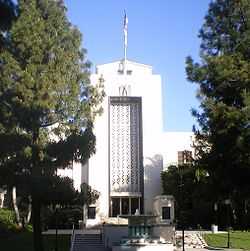Burbank City Hall
|
City Hall–City of Burbank | |
 | |
|
Burbank City Hall | |
 | |
| Location | 275 E. Olive Ave., Burbank, California |
|---|---|
| Coordinates | 34°10′55″N 118°18′27″W / 34.18194°N 118.30750°WCoordinates: 34°10′55″N 118°18′27″W / 34.18194°N 118.30750°W |
| Built | 1943 |
| Architect | William Allen and W. George Lutzi |
| Architectural style | Moderne |
| Governing body | Local |
| NRHP Reference # | 96000426[1] |
| Added to NRHP | April 18, 1996 |
Burbank City Hall is the site of the municipal government of Burbank, California, and is listed on the National Register of Historic Places.[1]
Designed by architects William Allen and W. George Lutzi in the Moderne or Art Deco style, ground was broken in February 1941 and construction was completed in 1943. The structure was funded by the Federal Works Agency, Works Project Administration (WPA). It was completed at a total cost of $409,000.
Burbank City Councilman Ted McConkey told the Los Angeles Daily News in 1996: "Anyone walking into City Hall would recognize that it's something unique. It's special because of the period in which it was built, because of the way it's been maintained and because of all the murals at City Hall. We get an inordinate number of requests to use City Hall from film companies."[2] When it was listed on the National Register of Historic Places in 1996, it became the second listed building in Burbank — the first being Burbank's main post office.
The structure's 77-foot tower serves as the main lobby and features art deco detailing and more than 20 types of marble, which can be found in the city seal on the floor, the trim, walls and in the treads and risers of the grand stairway.[2] Its notable features include bas relief sculptures.
Burbank City Hall is also noted for the large murals painted by famed muralist Hugo Ballin. Ballin also painted the murals at the Griffith Observatory and Wilshire Boulevard Temple. There are two major Ballin murals at the Burbank City Hall: "The Four Freedoms" in the Council Chamber and "Burbank Industry" in the rotunda. In 2001, the building underwent a renovation project that included restoration of the Ballin murals.
The Council Chamber located on the second floor is noted for its teakwood-panelled walls and Ballin's "Four Freedoms" mural. The mural was inspired by Franklin Roosevelt’s 1941 "Four Freedoms" speech and is considered one of Ballin's finest works. The chamber has built-in rails and tables. In 1978, the original carved wooden pews were replaced by padded theater-style seating, and the checkered floor was carpeted. During the 2001 renovation, the ceiling was returned to its original height revealing the top of the Four Freedoms mural that had been obscured for decades.
The "Burbank Industry" in the rotunda features Burbank-built airplanes, the motion picture industry, agriculture, and a power plant. In 1964 the bottom portion of the Burbank Industry mural was removed to make room for a bridge to an adjacent municipal building. After being stored for 37 years, the mural was restored in 2001 and the lower section reattached by art conservation experts.
References
- ↑ 1.0 1.1 "National Register Information System". National Register of Historic Places. National Park Service. 2007-01-23.
- ↑ 2.0 2.1 Lee Condon (1996). "Stylish Burbank City Hall Recognized". Daily News.
External links
- Ballin Murals at Burbank City Hall
- Council Chamber Renovation & Mural Restoration Project
- A Rare Visit Up the Tower of the Burbank City Hall
- Waymarking: Burbank City Hall
| ||||||||||||||||||||